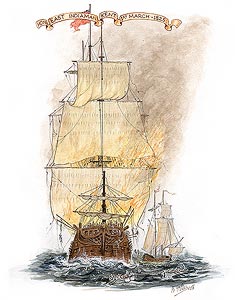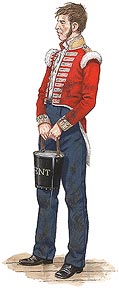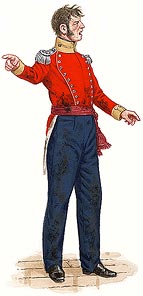The Burning Of The Indiaman ‘Kent’
1st March, 1825
“This was a noble Battalion saved
to the country by its own good soldiership”
Sir John Fortesque
 |
| An artists impression of the 'Kent' on fire. |
On the 7th of February, 1825 the 31st (Huntingdonshire) Regiment marched to Gravesend to embark for Calcutta: the headquarters and right wing on board the Honourable East India Company’s ship Kent, under Major Tovey. The two ships sailed at the end of February and parted company off Portsmouth. The Scaleby Castle, after a trouble free voyage, arrived at Sangor on the 7th June.
The voyage of the right wing of the regiment was the subject of a catastrophe by fire during a storm in the Bay of Biscay. On board were some 640 people. The ships company was 146 including officers, the remainder were officers and men of the 31st together with their families. The ship was crowded and uncomfortable and was loaded with 100 tons of shot and shell as well as the victuals and equipment for the voyage.
 |
| A Private of the Battalion Company. |
During a routine inspection of the after hold at 10 am a cask of rum spirit burst in a sudden lurch of the ship and a ship’s officer dropped his lantern. The flame ignited the spirit and within minutes the hold was ablaze. For some time it was thought the fire could be contained but it spread rapidly to the cabins and leaped through the hatchways.
The soldiers, with great fortitude and discipline under the direction of Colonel Fearon and the ship’s Captain, Henry Cobb used wet blankets, greatcoats and water to try and quell the blaze but it was soon evident that the fire was out of control. It became imperative that as many people as possible could be saved and the ship’s boats and some hastily built rafts were hoisted out. As many women and children as could be assembled wee put into the boats.
 |
| A Private of the Grenadier Company. |
Providently the brigantine Cambria of 200 tons en route for Mexico, under the command of Captain William Cobb with a crew of 11 appeared. Seeing the distress signal at the masthead the captain soon realised the plight of the stricken ship and immediately set about organising the help of every man aboard. He was also carrying 36 passengers who rendered invaluable aid. The rescue began between 2 and 3 pm with the women and children being lowered into the surviving boats, some already having been destroyed. Each trip took three quarters of an hour in the heaving swell. As each boat reached the Cambria, so the passengers and crew hauled everyone on board But not all went smoothly. The first boat, filled with women and children, were safely aboard when the sailors of the Kent tried to follow them. Roused by this cowardly act the passengers declared that until they had brought every individual from the Kent not one of them would enter Cambria. Thus compelled they returned to the Kent and the whole afternoon was spent in the effort to save those on board.
Captain Cook was fearful that the Kent would blow up at anytime and he had to be careful as to where he positioned himself for any burning debris could start a fire in the Cumbria. All the guns on the Kent were loaded as was the custom and these were likely to fire off at random as the flames reached them.
The loss of life that occurred was mainly caused by the impossibility of reaching all parts of the ship and the refusal of some men, at the end, to jump into the sea, doubtless because they could not swim. several drowned while swimming from the ship to the Cambria and others were crushed between the boats and the ships.
Captain Cobb and Colonel Fearon were the last men to leave the Kent when it was realised that no amount of persuasion could induce those seamen remaining to risk the now hazardous transfer to the boats. The only escape route left was to crawl along a spanker boom from the stern and slide down a rope into the small boat waiting below. With the ship still heaving and rolling the drop was as much as forty feet and it was no easy task. Colonel Fearon was not very fortunate for, after swinging some time and being repeatedly struck against the side of the boat and at one time drawn completely under it, he was so exhausted that he would have let go his rope had it not been for someone in the boat seizing his hair and dragging him aboard. He was terribly bruised and almost senseless.
The Kent blew up at 2am the following morning.
The conditions on the Cumbria must have been terrible in the extreme; the decks were crowded with people, many poorly clothed, some naked, standing ankle deep in water whilst down below eighty people, including most of the women, were packed into a cabin intended for ten. The foul air extinguished the candle and the hatches had to be opened between the rolling of the ship to let in air and not the sea. Amid all this horror a soldier’s wife gave birth to a daughter who not only survived but was named Cambria.
The loss of life was further reduced by the fact that fourteen survivors of the men who remained on the Kent were plucked from the sea, clinging to wreckage, by the Caroline bound for Liverpool from the Mediterranean.
Of the 640 on board the Kent 76 lives were lost including one woman and 21 children. It has to be said that Captain Cobb, Colonel Fearon and the officers and men of the 31st showed exceptional courage and discipline and without the humanity of Captain Cook and the courage of his crew and passengers of the tiny Cambria many more lives would have bee lost.
